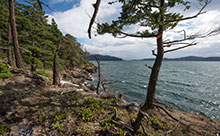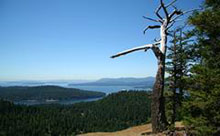The CRD has developed management plans for both Mount Parke and St. John Point Regional Parks on Mayne Island. These plans will provide strategic guidance for on-going management of both parks for the next 15-20 years.
About the Parks
 St. John Point is a 26-hectare waterfront property acquired in December 2017, and currently in park reserve status. Sensitive ecosystems in the park are considered at risk and ecologically fragile. Given this, St. John Point Regional Park is classified as a regional conservation area.
St. John Point is a 26-hectare waterfront property acquired in December 2017, and currently in park reserve status. Sensitive ecosystems in the park are considered at risk and ecologically fragile. Given this, St. John Point Regional Park is classified as a regional conservation area.
 Mount Parke Regional Park is 49 hectares. It was acquired in 1991 and expanded in 1992 through a generous private land donation. It offers forest walks, vistas, bird watching and spring wildflowers. It features the highest viewpoint (185m) on Mayne Island with summit views of other Gulf Islands and the Lower Mainland. It currently receives about 12,000 visits annually.
Mount Parke Regional Park is 49 hectares. It was acquired in 1991 and expanded in 1992 through a generous private land donation. It offers forest walks, vistas, bird watching and spring wildflowers. It features the highest viewpoint (185m) on Mayne Island with summit views of other Gulf Islands and the Lower Mainland. It currently receives about 12,000 visits annually.
Public Engagement
Management plans were approved for both parks on December 11, 2019. The plans are based on the information and input gathered through public engagement. Engagement included seeking input from First Nations, key government agencies, stakeholder groups and the public.
A first round of engagement was held in 2018. A second round of engagement was held in May-June 2019, with the public comment period ending June 9. The CRD thanks all those who completed the online comment form and those who attended the public sessions on Mayne Island. The information provided will helped the CRD finalize the management plans for approval by the CRD Board.
Park Planning Process
Given that both parks are on Mayne Island, efficiencies were realized in the consultation process by developing these plans concurrently. The planning process included opportunities for island residents, key stakeholders and the public across the CRD to provide input into how these areas are managed. We aimed to ensure that everyone's interests were considered.
Why Develop Park Management Plans?
Park management plans are a best practice. The purpose is to guide conservation, development, and use of the park over the next 15-20 years. The management plans include strategic direction (park vision, goals, and management statements relating to conservation and the provision of visitor opportunities), park zoning consistent with the park’s classification, key management actions, and a general implementation strategy. The CRD’s aim is to manage these parks in ways that are ecologically sound and supported by the public.